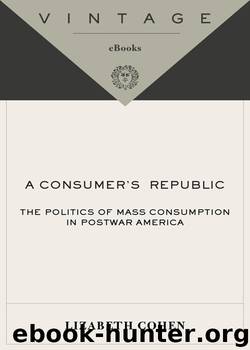A Consumers' Republic by Lizabeth Cohen

Author:Lizabeth Cohen [Cohen, Lizabeth]
Language: eng
Format: epub
ISBN: 978-0-307-55536-6
Publisher: Knopf Doubleday Publishing Group
Published: 2008-12-23T16:00:00+00:00
This ad from the November 1976 issue of Ms. magazine reveals how the women's movement of the 1970s encouraged mainstream advertisers to recognize and target a new feminist market. (Courtesy of Equitable Life Assurance Society of the United States)
Whereas social class and gender were marketing categories with histories that stretched back to the early twentieth century, two other kinds of market specialization—by age and by race or ethnicity—required the postwar revolution in market segmentation to flourish. Teenage, child, senior, black, and ethnic became more than labels for visible social groups; they became marketing segments that advertisers determined were well worth catering to.
If any kind of segmentation epitomized the hopes and success of the postwar marketing profession, it was segmenting by age, where stages of life, linked to patterns of purchasing, reshaped the mass market. One typical overview of the life cycle and buying behavior, published in 1966, identified nine categories, stretching from “Bachelor stage” and “Newly married couple” to “Full Nest I through III” (differentiated by children's ages), and culminating in “Empty Nest I and II” (distinguished by whether the head of household was working or retired) and “Solitary survivor,” both “in labor force” and “retired.” Each stage featured unique market behavior, with, for example, the Newly Married and Full Nesters at their peak in consumption of homes and consumer durables, while Empty Nesters shifted priorities to travel, luxuries, and medical care. Complementing this life cycle analysis, moreover, were intensive studies of certain key age markets. A special report in Printers' Ink at the dawn of market segmentation concluded that it was not just a question of marketers suddenly seeing age segments where once they had pictured only a family unit. Rather, whereas “a generation ago … purchases tended to reflect the needs of the family as a whole,” the meteoric rise of discretionary income in the postwar period had given each segment of the family more influence on purchase decisions, “and—to an extent that would have been considered unlikely in 1939—certain members of the family now have personal purchasing power.” Increasingly, the postwar family was becoming a collection of variously aged individuals with discrete consumer desires and capabilities.63
The first age cohort to attract marketers' attention was teenagers. The discovery of this teen market actually preceded the embrace of market segmentation, as promoters began experimenting with the idea in the 1940s, and its success contributed to the appeal of more extensive segmentation a decade or so later. A 1949 issue of Daniel Starch's marketing research newsletter, for example, was devoted to convincing advertisers of what today seems obvious: that greater profits would result from “writ[ing] special copy for magazines with special audiences” like the teenage readers of Seventeen magazine rather than using a standard sales pitch. Although “adolescence” had been labeled since the nineteenth century to signify a developmental stage, and “youth culture” referred to a select group of eighteen-to twenty-four-year-olds in the 1920s, it was not until a majority of teens were graduating from high school in the 1940s
Download
This site does not store any files on its server. We only index and link to content provided by other sites. Please contact the content providers to delete copyright contents if any and email us, we'll remove relevant links or contents immediately.
International Integration of the Brazilian Economy by Elias C. Grivoyannis(91925)
The Radium Girls by Kate Moore(11930)
Turbulence by E. J. Noyes(7942)
Nudge - Improving Decisions about Health, Wealth, and Happiness by Thaler Sunstein(7622)
The Black Swan by Nassim Nicholas Taleb(7016)
Rich Dad Poor Dad by Robert T. Kiyosaki(6414)
Pioneering Portfolio Management by David F. Swensen(6230)
Man-made Catastrophes and Risk Information Concealment by Dmitry Chernov & Didier Sornette(5926)
Zero to One by Peter Thiel(5691)
Secrecy World by Jake Bernstein(4652)
Millionaire: The Philanderer, Gambler, and Duelist Who Invented Modern Finance by Janet Gleeson(4386)
The Age of Surveillance Capitalism by Shoshana Zuboff(4216)
Skin in the Game by Nassim Nicholas Taleb(4165)
Bullshit Jobs by David Graeber(4101)
The Money Culture by Michael Lewis(4083)
Skin in the Game: Hidden Asymmetries in Daily Life by Nassim Nicholas Taleb(3935)
The Dhandho Investor by Mohnish Pabrai(3706)
The Wisdom of Finance by Mihir Desai(3659)
Blockchain Basics by Daniel Drescher(3511)
